
14 coaches online • Server time: 02:40
* * * Did you know? The most deaths in a single match is 8.
| Recent Forum Topics |
2009-05-04 18:00:16
66 votes, rating 5.6
66 votes, rating 5.6
Some notes on caging and screening tactics.
Well I've decided to try my hand at a short tactics article. This first article concerns some tips to consider when caging and screening. It is aimed at beginner - intermediate players who have already mastered the basics of caging, and want to extend their strategies a bit further. The pictures shown are to illustrate concepts only and do not necessarily demonstrate the optimal play under the given circumstances.
Basic caging
Firstly, the basic tight 5 player cage is probably well familiar to anyone who has played a Blood Bowl game. It looks like this:

The classic cage strategy is
Saving a cage under threat
Sometimes when a cage is under a lot of pressure, it is not possible ensure that opponent players are not in contact with the cage at the end of the turn (did I hear stand firm blodger?).
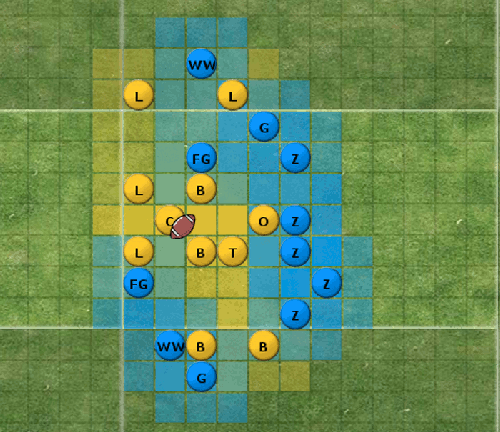
Don't panic! Clearly those Flesh Golems pose a problem. But there is a way to prevent a blitz on the Human ball carrier without moving the cage.
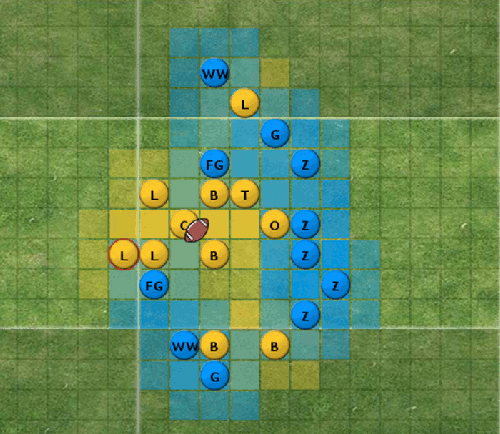
Double caging
This next idea is designed to prevent a cage coming under too much pressure to begin with. Basically, create a second wall of players (usually on the same side as the bulk of the opponent players).
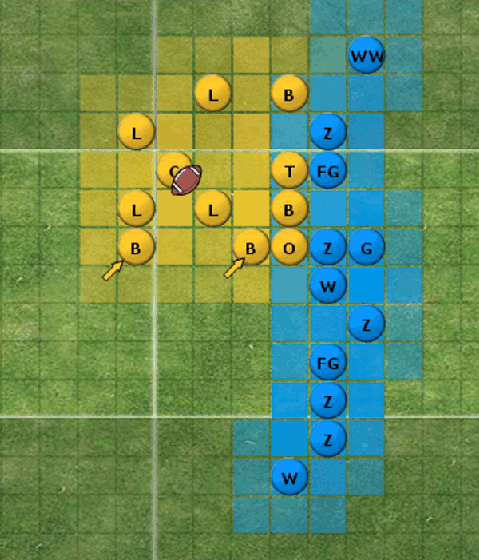
The arrows point to two blitzers that prevent the cage from being attacked on the side. It is unlikely that the Necro player would be able to get someone next to the ball carrier in his turn.
Doubling of the cage is usually a luxury, as it is rare to have spare players available. Often just doubling the front corners can help a lot. This will leave your opponent only the rear to attack. If he does this, a blitz (or at worst a dodge) will be enough to free the ball carrier and he can head off again down field.
One final point: shifting the offence to one side (as shown above) is almost always a bad idea. Your opponent now only has 2/3 of the field to defend. A good opponent will compress their defence and make your progress difficult.
Cage advancement
When an opportunity presents itself to move the cage forward, consider forming screens so that the turn after the cage can move again.
Now the Necro team has a turn with the ball. The Human team has decided to be aggressive and sent players around the back to attack the cage from the rear.
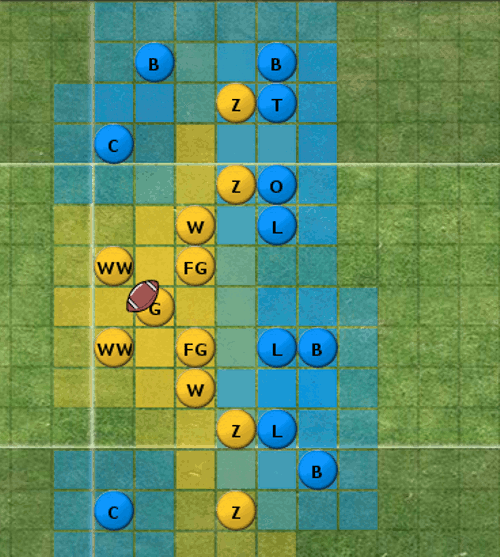
The Necro team blitzes a hole with a slow player (keeping the faster players available for penetration). Players move around the sides to screen the advance (see arrows). The cage moves right up the centre. Thanks to the screening players, the Humans will be hard pressed to get back into position.
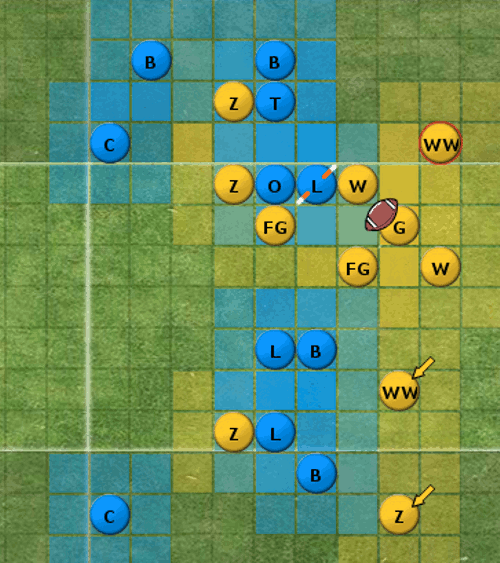
Double walls
Double walls are often used by patient coaches with Amazons and Elves in defence. They work great on the offence too! The beauty of a double wall is its impenetrability without the aid of pointy ears or Nuffle.
In this next play, the Humans have made a player protective setup, which has become popular due to its use by some of the highest ranked FUMBBL coaches. On their first turn the Necro have received the ball and kept it deep. They have made a double wall along a flank. The Humans will be hard pressed to stop a ghoul hand-off and extremely deep penetration on the following Necro turn.
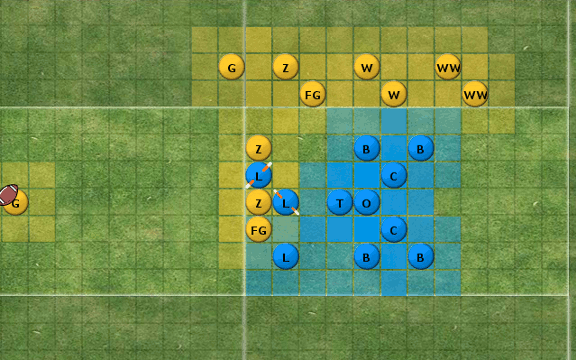
Some teams can make 2 turn TDs in this way, with a hand-off and a quick pass. Other times it can be used mid-drive to screen a break up the side zone.
Well that's it for now. Hope it helps some coaches out there.
Grod.
Basic caging
Firstly, the basic tight 5 player cage is probably well familiar to anyone who has played a Blood Bowl game. It looks like this:

The classic cage strategy is
- Use the other players to punch holes in the defense
- Roll the cage around to make progress down the field.
- Make sure that the corners of the cage are not in contact with a standing opponent player at the end of the turn.
Saving a cage under threat
Sometimes when a cage is under a lot of pressure, it is not possible ensure that opponent players are not in contact with the cage at the end of the turn (did I hear stand firm blodger?).
Don't panic! Clearly those Flesh Golems pose a problem. But there is a way to prevent a blitz on the Human ball carrier without moving the cage.
Double caging
This next idea is designed to prevent a cage coming under too much pressure to begin with. Basically, create a second wall of players (usually on the same side as the bulk of the opponent players).
The arrows point to two blitzers that prevent the cage from being attacked on the side. It is unlikely that the Necro player would be able to get someone next to the ball carrier in his turn.
Doubling of the cage is usually a luxury, as it is rare to have spare players available. Often just doubling the front corners can help a lot. This will leave your opponent only the rear to attack. If he does this, a blitz (or at worst a dodge) will be enough to free the ball carrier and he can head off again down field.
One final point: shifting the offence to one side (as shown above) is almost always a bad idea. Your opponent now only has 2/3 of the field to defend. A good opponent will compress their defence and make your progress difficult.
Cage advancement
When an opportunity presents itself to move the cage forward, consider forming screens so that the turn after the cage can move again.
Now the Necro team has a turn with the ball. The Human team has decided to be aggressive and sent players around the back to attack the cage from the rear.
The Necro team blitzes a hole with a slow player (keeping the faster players available for penetration). Players move around the sides to screen the advance (see arrows). The cage moves right up the centre. Thanks to the screening players, the Humans will be hard pressed to get back into position.
Double walls
Double walls are often used by patient coaches with Amazons and Elves in defence. They work great on the offence too! The beauty of a double wall is its impenetrability without the aid of pointy ears or Nuffle.
In this next play, the Humans have made a player protective setup, which has become popular due to its use by some of the highest ranked FUMBBL coaches. On their first turn the Necro have received the ball and kept it deep. They have made a double wall along a flank. The Humans will be hard pressed to stop a ghoul hand-off and extremely deep penetration on the following Necro turn.
Some teams can make 2 turn TDs in this way, with a hand-off and a quick pass. Other times it can be used mid-drive to screen a break up the side zone.
Well that's it for now. Hope it helps some coaches out there.
Grod.
Comments
Posted by Ehlers on 2009-05-04 18:47:26
Nice review.
But should be posted in the wiki pages or could have been an ariticle in GLN (for trying to get it back alive and kicking).
Just this blog post will vanish among all the others, which would be a sad point :(
But should be posted in the wiki pages or could have been an ariticle in GLN (for trying to get it back alive and kicking).
Just this blog post will vanish among all the others, which would be a sad point :(
Posted by SillySod on 2009-05-04 19:26:09
Neat.
How resilient do you find the double wall to be over multiple turns? One problem with scoring down the sideline is that it often takes three turns to get the ball to the endzone without too high a chance of dropping it.
How resilient do you find the double wall to be over multiple turns? One problem with scoring down the sideline is that it often takes three turns to get the ball to the endzone without too high a chance of dropping it.
Posted by PigStar-69 on 2009-05-04 19:32:17
very nice blog sir.
Posted by Grod on 2009-05-04 20:44:07
@ Ehlers: Thanks. Since this was my first attempt at a tactics article, I thought it was easier to develop as a blog post. Perhaps once I have polished it off, it could be published elsewhere.
@ Sillysod: Yeah, going down the sideline is always tricky. I try to avoid doing it unless I can create a channel or screen beforehand that will get the ball far down field. In the situation above, an aggressive opponent can dissolve that within two turns, although weaker opponents often won't. Usually I evolve the structure somewhat in the following turn, either to a cage or shifted screen (or combination), but the hand-off, quick pass is also a possibility for a 2 - turn TD (especially for dark elves and the like). A cage near the sideline can be sometimes OK, such as when it is close to the opponents end zone with turns to spare :)
@ Sillysod: Yeah, going down the sideline is always tricky. I try to avoid doing it unless I can create a channel or screen beforehand that will get the ball far down field. In the situation above, an aggressive opponent can dissolve that within two turns, although weaker opponents often won't. Usually I evolve the structure somewhat in the following turn, either to a cage or shifted screen (or combination), but the hand-off, quick pass is also a possibility for a 2 - turn TD (especially for dark elves and the like). A cage near the sideline can be sometimes OK, such as when it is close to the opponents end zone with turns to spare :)
Posted by clockbob on 2009-05-04 22:43:29
I find the sideline example is only useful when attempting a 2 turn touchdown. otherwise the passing and running lanes close, and you end up in a bashing battle that you will probably lose.
I find when trying to play the sidelines, it helps to send 1 player or 2 down the other side line, especially a lineman. opponents will often ignore this player, giving you another option for the score.
I find when trying to play the sidelines, it helps to send 1 player or 2 down the other side line, especially a lineman. opponents will often ignore this player, giving you another option for the score.
Posted by Vol on 2009-05-05 02:22:29
Very well done.
Posted by Bruhammer on 2009-05-05 12:59:57
Very good. Nice stuff to develop own ideas.
Posted by ibambe on 2009-05-21 00:20:21
On your double wall, couldn't the humans just flood the backfield by blitzing the top most zombie on the los? This would force a risky pass to the wights over the heads of the catchers.
If the necros need to score quickly, it would be pretty easy to get a couple tzs on the wights and werewolves. If it's early in the half, I might prefer to go after those lonely werewolves. That T stands for a lineman with DP right? :)
If the necros need to score quickly, it would be pretty easy to get a couple tzs on the wights and werewolves. If it's early in the half, I might prefer to go after those lonely werewolves. That T stands for a lineman with DP right? :)
Posted by Grod on 2009-05-21 12:30:26
@ ibambe: this is just an example I made quickly to illustrate a concept. It can be used very effectively in many ways, depending on the teams involved and with careful placement of the players.

